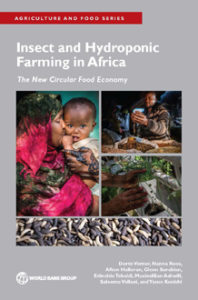Recently, the World Bank published a book describing insect farming as disruptive, inclusive, and resilient solution to Africa’s wide-ranging food security challenges. It assesses the benefits and costs of using the frontier agriculture technologies to create a circular food economy in Africa. This book focuses on two types of frontier agriculture technologies: insect farming and hydroponic crop farming. Both technologies quickly produce nutritious human food and animal feed and could provide tremendous health, social, economic, climatic, environmental, and food security benefits in Africa.
Insect farming can create a circular food economy by reusing society’s organic waste, including agricultural and certain industrial waste, to produce foods for humans, fish, and livestock without the need for vast amounts of arable land or water resources. It shows great potential for growth and scalability as the market is rapidly increasing for novel protein sources from farmed insects. Estimates show that the market for farmed insects for human food and animal feed will be worth up to US$8 billion by 2030, with a 24 percent compound annual growth rate (MarketWatch 2019).
As the report shows, insect farming can create jobs, diversify livelihoods, improve nutrition, and provide many other benefits in African and fragile, conflict-affected countries. Good practices in Kenya and Uganda are incorporated in the report, as well the crickets! This report underpins the potential of Flying Food – our approach and the business case.
Read more in the book of the World Bank: Insect and Hydroponic Farming in Africa – The New Circular Food Economy

